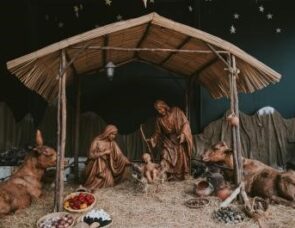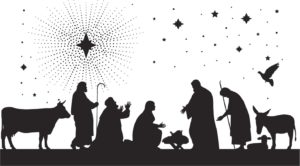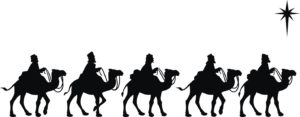Exploring the original Bible stories of the nativity, as found in the Christian Gospels.

Introduction for teachers
Exploring the original Bible stories of the nativity, as found in the Christian Gospels.
Religious Education
- Comparing the original nativity narratives with traditional (later) versions, and evaluating the underlying meaning of the original.
Literacy
- Reading comprehension: examining a test for clues.
- Summarising the key ideas in a narrative.
Preparation
Every pupil will need a copy of the Bible detective worksheet.
Pupils will need access to copies of the original Bible stories in pupil-friendly translations, as found in Matthew 1:18–25; 2:1–18; Luke 1:26–38; 2:1–20.
Pupil-friendly versions of the text can be found in the Good News Translation or the Contemporary English Version, among others. If you are using a set of Bibles, you may need to explain how the chapter-and-verse system works. Alternatively, print out the relevant sections that may be downloaded from a variety of websites, including www.biblegateway.com.
You may also wish to find and display a few popular images of the nativity story, for comparison with the original texts, but please ensure you have the necessary permission before using any images obtained from the Internet.


Introduction: who did you play?
Which of you took part in a nativity play when you were smaller? Stand up if you were ever: a shepherd; a king; a wise man; a sheep; an angel; an innkeeper; a donkey; a wandering star. Is there anyone or anything else we’ve left out? (Mary, Joseph and baby Jesus?) Can you remember what happens in the nativity story?
Use pupil discussion to draw up a class collective ‘memory’ of the story on the board, listing all the traditional elements, including a stable.
Pupils should discuss with a partner – which of these listed story elements were in the original Bible story? Which bits of the story do we think are ‘true’, and why?
Development: Bible detectives!
Explain that we are now going to stage an investigation. We are going to find out what the original narratives actually say about the birth of Jesus, and you may be surprised. The Bible story is the one that all the nativity plays and Christmas cards are based on, and it’s about 2,000 years old. There are two accounts of the birth of Jesus, written by his friends Matthew and Luke. Just like a real detective or archaeologist, you are going to examine the evidence and then give your opinions about the original Christmas story!
Distribute copies of the Bible detective worksheet. From the list of story elements already on display, which of these do your pupils think are the key elements (most important bits) of the story? Together create a class list of agreed key elements, with each pupil then noting them in the first column on their worksheet. (Also do this on a display board to show how it works.)
The class will now need modern translations of the original birth narratives found in the New Testament of the Christian Bible at:
- Matthew 1:18–25 and 2:1–18
- Luke 1:26–38 and 2:1–20
Read aloud the whole Matthew narrative, with the class following in their own copies. (Expect giggles at the mention of the word ‘virgin’, and some shock at the account of the massacre of the children.) Afterwards, ask which of the supposed elements happened in this version. Were there any they didn’t expect? List them together on the board.
Pupils should then complete the same exercise using Luke’s narrative, working either independently or in pairs, to then move on to the more able questions (see below). Afterwards share discoveries in a mini plenary. Some possible pupil discoveries:
- The shepherds and the wise men are mentioned in different Gospels but not together
- There’s no mention of a donkey, an innkeeper or a stable. The family could have been staying inside an inn or the house of one of Joseph’s relatives, but there was no cradle, so they had to improvise with a manger.
- Jesus was nearly killed by Herod’s soldiers.
- Joseph was originally thinking of cancelling the marriage to Mary.
- The wise men didn’t ‘follow the star’ to Bethlehem; they turned up at Herod’s palace in Jerusalem, thinking the baby was born in the obvious place – a royal palace. Herod’s researchers later sent them on to Bethlehem.
- There were no ‘kings’, unless you count Herod.
- There was no snow, robins or Father Christmas!
Differentiation
To tackle the Luke passage, SEN pupils will need either an adult reader or to be paired up with a more able child.
More able pupils should be challenged by being offered one or more of the following questions:
- Which do you think are the three most important bits of the story of the nativity? Why? Explain your choice.
- Why do you think people have sometimes added these other elements (the donkey, the kings or the stable) to the story and left out some of the nastier bits?
- Do you think it matters if you add a donkey, a stable or three kings? Does changing the story matter in some way? How?
Extension activities
- Study one or more traditional images of the nativity story. How much do we think they reflect the details of the original story?
- Retell the narrative of the original Gospel Christmas story in a ‘mini saga’ of exactly 50 words. Pupils will need to include at least five key elements to succeed in this.
- Explain why you think this story is still told around the world, and performed in many schools at Christmas. What makes it popular with so many people?
- Create a set of commemorative stamps for Royal Mail that retell key elements of the original nativity story. If there is time, design and make a special folder to keep them in, which should include a written explanation of the key elements portrayed on each stamp.
Plenary
Discuss:
- What are the most important messages this story is actually saying about:
- Jesus?
- powerful people?
- poorer, not-so-powerful people?
- God?
- Why do you think this story is still told around the world?
Background information for teachers
School nativity plays can be great fun, but the significance of the Messiah’s birth can be lost in the general storytelling. This lesson gives pupils the opportunity to discover more about the original accounts.
The star in the original narrative is seen to ‘go ahead’, but all stars appear to ‘move’ through the night, since we live on a revolving planet. For the Magi, however, this star had particular significance, so its varying position in the night sky might have been relevant to their journey. They were probably astrologers from Babylon in the Persian empire, close to Baghdad, the capital of modern-day Iraq. The intrusion of these foreigners into the nativity caused a great deal of upset and disaster for the people of Bethlehem.
The shepherds on the hills were poor herdsmen, probably the least important members of their society. Their working lifestyle prevented them from undertaking the traditional Jewish religious practices of daily ritual washing, making them ritually ‘unclean’. However, they were the first in the vicinity to be told about the Messiah’s birth.
The angels appear as supernatural messengers of God. Notice how often their message includes ‘Do not be afraid’.
Photo by Walter Chávez on Unsplash

 Download
Download